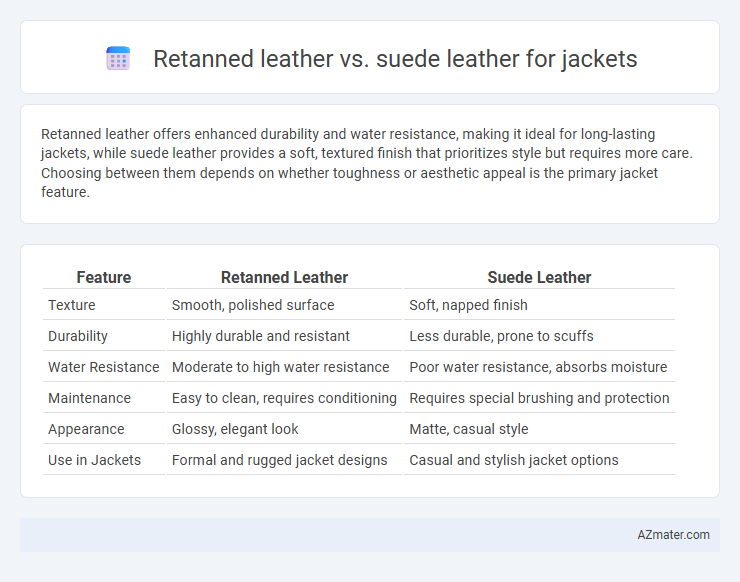Retanned leather offers enhanced durability and water resistance, making it ideal for long-lasting jackets, while suede leather provides a soft, textured finish that prioritizes style but requires more care. Choosing between them depends on whether toughness or aesthetic appeal is the primary jacket feature.
Table of Comparison
| Feature | Retanned Leather | Suede Leather |
|---|---|---|
| Texture | Smooth, polished surface | Soft, napped finish |
| Durability | Highly durable and resistant | Less durable, prone to scuffs |
| Water Resistance | Moderate to high water resistance | Poor water resistance, absorbs moisture |
| Maintenance | Easy to clean, requires conditioning | Requires special brushing and protection |
| Appearance | Glossy, elegant look | Matte, casual style |
| Use in Jackets | Formal and rugged jacket designs | Casual and stylish jacket options |
Introduction to Retanned and Suede Leather
Retanned leather undergoes a secondary tanning process that enhances durability, suppleness, and water resistance, making it ideal for high-quality jackets that require both strength and comfort. Suede leather, derived from the underside of the animal hide, features a soft, napped finish that provides a distinct texture and stylish appearance but is less resistant to moisture and wear. Choosing between retanned and suede leather depends on the desired balance between ruggedness and fashion-forward softness in jacket construction.
What is Retanned Leather?
Retanned leather undergoes a secondary tanning process to enhance durability, softness, and color uniformity, making it ideal for jackets that require long-lasting wear and a polished appearance. Unlike suede leather, which is made from the underside of the hide and features a soft, napped finish, retanned leather maintains a smooth surface and improved resistance to moisture and abrasion. This treatment process results in jackets that combine aesthetic appeal with functional performance, suitable for both casual and formal use.
What is Suede Leather?
Suede leather is made from the underside of animal hide, primarily from lamb, goat, or calf, resulting in a napped finish that is soft and pliable. Unlike retanned leather, which undergoes additional tanning to enhance durability and water resistance, suede maintains a velvety texture but is more susceptible to stains and moisture damage. Suede jackets offer a lightweight, stylish option with a distinctive texture but require careful maintenance compared to the tougher, more resilient retanned leather jackets.
Manufacturing Processes: Retanned vs Suede
Retanned leather undergoes an additional tanning process after the initial chrome or vegetable tanning to enhance durability, flexibility, and color richness, making it ideal for jackets requiring longevity and resistance. Suede leather is produced by sanding the inner surface of a split hide, resulting in a soft, napped finish that prioritizes texture and appearance but requires delicate handling and specialized protection treatments. The distinct manufacturing processes of retanned leather and suede significantly affect their performance and maintenance in jacket applications.
Texture and Appearance Differences
Retanned leather offers a smoother, denser texture with a glossy or polished finish, making it durable and resistant to wear for jackets. Suede leather features a soft, napped surface with a velvety feel, providing a matte appearance that exudes casual elegance but is more prone to stains and abrasion. The contrasting textures result in retanned leather jackets showcasing a sleek, structured look, while suede jackets deliver a soft, luxurious aesthetic with a more relaxed vibe.
Durability and Longevity Comparison
Retanned leather offers superior durability and longevity compared to suede leather due to its dense fiber structure and enhanced treatment processes that increase resistance to wear and moisture. Suede leather, characterized by its soft, napped finish, is more prone to scratches, stains, and weather damage, which reduces its lifespan in heavy-use jackets. For long-lasting outerwear, retanned leather provides a robust option that maintains its appearance and strength over time, whereas suede requires more careful maintenance to preserve its delicate texture.
Comfort and Flexibility for Jackets
Retanned leather offers enhanced comfort and flexibility for jackets due to its softer texture and improved moisture retention compared to traditional leather, making it ideal for extended wear. Suede leather, characterized by its napped finish, provides a plush and breathable feel but may lack the same degree of durability and stretchiness found in retanned options. Choosing between retanned and suede leather jackets depends on the balance of desired comfort, flexibility, and maintenance requirements.
Maintenance and Care Requirements
Retanned leather jackets require regular conditioning with specialized leather creams to maintain their suppleness and prevent cracking from moisture exposure, while suede leather jackets demand gentle brushing with a suede brush and protection using water-repellent sprays to avoid staining and damage from water. Retanned leather is more resistant to dirt and easier to clean with leather-specific cleaners, whereas suede is delicate and prone to staining, requiring careful spot cleaning with suede erasers or mild soaps. Both types necessitate storage in a cool, dry place away from direct sunlight to preserve their texture and color, but suede jackets particularly benefit from breathable garment bags to prevent mildew buildup.
Cost Considerations: Retanned vs Suede Jackets
Retanned leather jackets generally cost more due to the intensive processing involved, enhancing durability and water resistance compared to suede. Suede jackets, derived from the underside of the hide, offer a softer texture but typically require more maintenance and are less resistant to stains and moisture, resulting in potential long-term expenses. Evaluating initial cost versus upkeep is crucial when choosing between retanned and suede leather jackets for budget-conscious buyers.
Choosing the Best Leather for Your Jacket
Retanned leather offers enhanced durability, water resistance, and a smooth texture ideal for jackets requiring longevity and protection from the elements. Suede leather provides a soft, luxurious feel with a matte finish but requires more maintenance and is less resistant to moisture and stains. Choosing the best leather depends on your lifestyle and style preferences: retanned leather suits active use and harsh conditions, while suede is better for fashion-forward, gentle wear.

Infographic: Retanned leather vs Suede leather for Jacket
 azmater.com
azmater.com